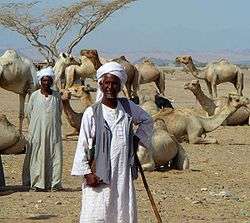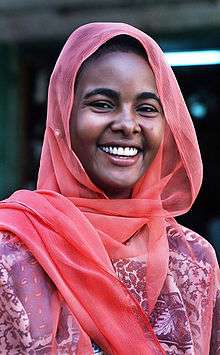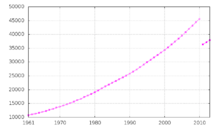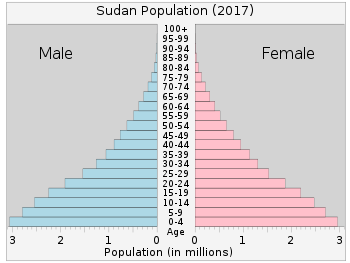Demographics of Sudan
Sudanese people (Arabic: سودانيون) and the demographic features of the population of Sudan, including population density, ethnicity, education level, health of the populace, economic status, religious affiliations and other aspects of the population.


.jpg)




In Sudan's 1993 census, the population was calculated at 30 million. No comprehensive census has been carried out since that time due to the civil war. Estimates of Sudan, including the population of South Sudan, ranged from 37 million (United Nations estimate) to 45 million (CIA estimate). Since the secession of South Sudan in July 2011, estimates place the current population of Sudan at about 42 million[1][2]. The population of metropolitan Khartoum (including Khartoum, Omdurman, and Khartoum North) is growing rapidly and ranges from six to seven million, including around two million displaced persons from the southern war zone as well as western and eastern drought-affected areas.
Population overview
The majority of the population of Sudan is a result of intermarriage between the indigenous Nubian inhabitants of the Nile Valley, and descendants of migrants from the Arabian Peninsula and mostly North Africa. Due to the process of Arabisation common throughout the rest of the Arab world, today Arab culture predominates in Sudan. The majority of ethnic groups of Sudan fall under Arabs, and the minority being African ethnic groups such as Nubians, Beja,[3] Fur, Nuba, and Fallata.[4] When counted as one people Sudanese Arabs are by far the largest ethnic group in Sudan, however African ethnic groups are a large minority if counted as one group. They are almost entirely Muslim; while the majority speak Sudanese Arabic; some other Arab tribes speak different Arabic dialects like Awadia and Fadnia and Bani Arak tribes who speak Najdi Arabic; Bani Hassan, Al-Ashraf, Kinanah and Rashaida who speak Hejazi Arabic. In addition, Arab tribes like the Baggara and other Darfurians, both who speak Chadian Arabic.[5] Sudanese Arabs of northern and eastern parts descend primarily from migrants from the Arabian Peninsula and some of the pre-existing indigenous populations of Sudan, most predominately the Nubian people who also share a common history with Egypt. Additionally, a few pre-Islamic Arabian tribes existed in Sudan from earlier migrations into the region from Western Arabia, although most Arabs in Sudan are dated from migrations after the 12th century.[6] The vast majority of Arab tribes in Sudan migrated into the Sudan in the 12th century, intermarried with the indigenous African populations and introduced Islam.[7]
Population statistics
Achieving good counts of the population is difficult in Sudan, because conducting a census has been difficult due to various conflicts and wars in the southern, eastern and western regions of Sudan over the past few decades. The government of South Sudan (led by the former SPLM resistance movement) has in the past accused Sudan of deliberately manipulating the census in oil-rich regions such as the Abyei district, on the border between Sudan and South Sudan. The population count is a determining factor for the share of wealth and power each part of Sudan receives after the secession of South Sudan (See: Naivasha Agreement). Another complication is the Southern Sudanese refugees present in the north, whose citizenship in Sudan after the secession of South Sudan is now in question.[8] 250,000 refugees from Syria live in Sudan.[9]
Vital statistics[10]
The vital statistics below include South Sudan.
| Period | Live births per year | Deaths per year | Natural change per year | CBR* | CDR* | NC* | TFR* | IMR* |
|---|---|---|---|---|---|---|---|---|
| 1950-1955 | 452 000 | 233 000 | 219 000 | 46.5 | 24.0 | 22.5 | 6.65 | 160 |
| 1955-1960 | 510 000 | 251 000 | 259 000 | 46.7 | 23.0 | 23.8 | 6.65 | 154 |
| 1960-1965 | 572 000 | 268 000 | 304 000 | 46.6 | 21.8 | 24.7 | 6.60 | 147 |
| 1965-1970 | 647 000 | 281 000 | 365 000 | 46.5 | 20.3 | 26.3 | 6.60 | 137 |
| 1970-1975 | 737 000 | 298 000 | 438 000 | 46.2 | 18.7 | 27.5 | 6.60 | 126 |
| 1975-1980 | 839 000 | 317 000 | 522 000 | 45.1 | 17.1 | 28.1 | 6.52 | 116 |
| 1980-1985 | 950 000 | 339 000 | 611 000 | 43.6 | 15.5 | 28.0 | 6.34 | 106 |
| 1985-1990 | 1 043 000 | 361 000 | 682 000 | 41.7 | 14.4 | 27.3 | 6.08 | 99 |
| 1990-1995 | 1 137 000 | 374 000 | 763 000 | 40.1 | 13.2 | 26.9 | 5.81 | 91 |
| 1995-2000 | 1 242 000 | 387 000 | 855 000 | 38.6 | 12.0 | 26.6 | 5.51 | 81 |
| 2000-2005 | 1 324 000 | 373 000 | 951 000 | 36.5 | 10.3 | 26.2 | 5.14 | 70 |
| 2005-2010 | 1 385 000 | 384 000 | 1 001 000 | 33.8 | 9.4 | 24.4 | 4.60 | 64 |
| * CBR = crude birth rate (per 1000); CDR = crude death rate (per 1000); NC = natural change (per 1000); IMR = infant mortality rate per 1000 births; TFR = total fertility rate (number of children per woman) | ||||||||
Life expectancy at birth (only North Sudan)
| Period | Life expectancy in Years[11] |
|---|---|
| 1950–1955 | 44.54 |
| 1955–1960 | |
| 1960–1965 | |
| 1965–1970 | |
| 1970–1975 | |
| 1975–1980 | |
| 1980–1985 | |
| 1985–1990 | |
| 1990–1995 | |
| 1995–2000 | |
| 2000–2005 | |
| 2005–2010 | |
| 2010–2015 |
Ethnic groups
- Sudanese Arabs (approximately 70%)[12]
- Fur people
- Beja people
- Nuba people
- Nubian people
Languages
The most widely spoken languages in Sudan are:
- Arabic language:
- Sudanese Arabic.
- Najdi and Hejazi Arabic, (mainly in mid-north and mid-east regions).
- Chadian Arabic in western region, (mainly spoken by Baggara and various Arabized African tribes).
- Nubian language in far north, (mainly spoken by Nubians of Mahas, Dongola and Halfa).
- Beja language knows as Bedawit in far east alongside Red sea, (mainly spoken by Beja of Hadandawa, Ababda and Bisharin).
Before 2005, only Arabic was the official language.[13] In the 2005 constitution, Sudan's official languages became Arabic and English:[14]
Article 8:
- All indigenous languages of Sudan are national languages and shall be respected, developed and promoted.
- Arabic is a widely spoken national language in Sudan.
- Arabic, as a major language at the national level and English shall be the official working languages of the national government and the languages of instruction for higher education.
- In addition to Arabic and English, the legislature of any sub-national level of government may adopt any other national language as an additional official working language at its level.
- There shall be no discrimination against the use of either Arabic or English at any level of government or stage of education.
The working constitution of the post-2019 Revolution transitional period specifies no national language.
Religion
97% of the population adheres to Islam, with the overwhelming majority being adherents of the Sunni Sufi branch and the Maliki school of Islamic jurisprudence.[16] The remainder of the population follows either animist and indigenous beliefs or Christianity, especially in Khartoum and in southern regions of the country bordering South Sudan.
Christians in Sudan which are refugees or immigrants from the south belong to various churches including the Roman Catholic Church, small Melkite and Maronite communities in the north, as well as Anglicans followers in the Episcopal Church of Sudan and the recently formed Reformed Episcopal Church. There are significant but long-established groups of Coptic Orthodox and Greek Orthodox Christians in Khartoum and other northern cities.
There are also Ethiopian and Eritrean Orthodox communities in Khartoum and eastern Sudan, largely made up of refugees and migrants from the past few decades. Other Christian groups with smaller followings in the country include the Africa Inland Church, the Armenian Apostolic Church, the Sudan Church of Christ, the Sudan Interior Church, Jehovah's Witnesses, the Sudan Pentecostal Church, the Sudan Evangelical Presbyterian Church (in the North).
Religious identity plays a role in the country's political divisions. Northern and western Muslims have dominated the country's political and economic system since independence. The NCP draws much of its support from Islamists, Salafis/Wahhabis and other conservative Arab Muslims in the north. The Umma Party has traditionally attracted Arab followers of the Ansar sect of Sufism as well as non-Arab Muslims from Darfur and Kordofan.
The Democratic Unionist Party (DUP) includes both Arab and non-Arab Muslims in the north and east, especially those in the Khatmia Sufi sect.
Other demographic statistics
Demographic statistics according to the World Population Review in 2019.[17]
- One birth every 23 seconds
- One death every 2 minutes
- One net migrant every 13 minutes
- Net gain of one person every 32 seconds
The following demographic are from the CIA World Factbook[18] unless otherwise indicated.
Population
- 43,120,843 (July 2018 est.)
- 35,482,233 (July 2014 est.)
Age structure

- 0-14 years: 43.07% (male 9,434,634 /female 9,136,951)
- 15-24 years: 20.22% (male 4,459,335 /female 4,259,341)
- :25-54 years: 29.8% (male 6,236,954 /female 6,612,593)
- 55-64 years: 3.93% (male 876,614 /female 819,048)
- 65 years and over: 2.98% (male 688,391 /female 596,982) (2018 est.)
- 0–14 years: 40.8% (male 7,356,059/female 7,131,497)
- 15–24 years: 20.2% (male 3,704,700/female 3,476,847)
- 25–54 years: 31.8% (male 5,465,816/female 5,800,619)
- 55–64 years: 3.3% (male 737,831/female 652,428)
- 65 years and over: 3.3% (male 633,083/female 523,353) (2014 est.)
Median age
- total: 17.9 years. Country comparison to the world: 214th
- male: 17.7 years
- female: 18.1 years (2018 est.)
Birth rate
- 34.2 births/1,000 population (2018 est.) Country comparison to the world: 23rd
Death rate
- 6.7 deaths/1,000 population (2018 est.) Country comparison to the world: 139th
Total fertility rate
- 4.85 children born/woman (2018 est.) Country comparison to the world: 17th
Population growth rate
- 2.93% (2018 est.) Country comparison to the world: 9th
Contraceptive prevalence rate
- 12.2% (2014)
Net migration rate
- 1.9 migrant(s)/1,000 population (2018 est.) Country comparison to the world: 52nd
Dependency ratios
- total dependency ratio: 81.6 (2015 est.)
- youth dependency ratio: 75.4 (2015 est.)
- elderly dependency ratio: 6.3 (2015 est.)
- potential support ratio: 15.9 (2015 est.)
Urbanization
- urban population: 34.6% of total population (2018)
- rate of urbanization: 3.17% annual rate of change (2015-20 est.)
Religions
Sunni Muslim, small Christian minority
Life expectancy at birth
- total population: 65.8 years
- male: 63.7 years
- female: 68.1 years (2018 est.)
- total population: 63.32 years
- male: 61.27 years
- female: 65.46 years (2014 est.)
Nationality
noun:
Sudanese (singular and plural)
adjective:
Sudanese
Sex ratio
at birth:
1.05 male(s)/female
0–14 years:
1.03 male(s)/female
15–24 years:
1.06 male(s)/female
25–54 years:
0.94 male(s)/female
55–64 years:
1.1 male(s)/female
65 years and over:
1.19 male(s)/female
total population:
1.18 male(s)/female (2014 est.)
Literacy
definition: age 15 and over can read and write (2015 est.)
- total population: 75.9%
- male: 83.3%
- female: 68.6% (2015 est.)
- total population: 71.9%
- male: 80.7%
- female: 63.2%
- note: pre-secession of South Sudan (2011 est.)
School life expectancy (primary to tertiary education)
- total: 8 years
- male: 8 years
- female: 7 years (2015)
Unemployment, youth ages 15-24
- total: 20%
- male: 16%
- female: 32% (2009 est.)
References
| Wikimedia Commons has media related to Demographics of Sudan. |
- ""World Population prospects – Population division"". population.un.org. United Nations Department of Economic and Social Affairs, Population Division. Retrieved November 9, 2019.
- ""Overall total population" – World Population Prospects: The 2019 Revision" (xslx). population.un.org (custom data acquired via website). United Nations Department of Economic and Social Affairs, Population Division. Retrieved November 9, 2019.
- Copts migration
- https://www.cia.gov/library/publications/the-world-factbook/geos/su.html
- The Darfur Conflict: Geography Or Institutions? Osman Suliman, Mohamed Osman Suliman, p.115
- وزير خارجية السودان الاسبق حسين ابوصالح ل"الشرق" : التهديدات الامريكية للسودان كانت تصلنا في ورقة صغيرة دون ترويسة اوامضاء
- Royal Anthropological Institute of Great Britain and Ireland, JSTOR (Organization) (1888). Journal of the Royal Anthropological Institute of Great Britain and Ireland, Volume 17. p. 16. Retrieved 8 May 2011.
- Broere, Kees. "Uitstel voor census Soedan". de Volkskrant, 15 April 2008, p. 5.
- https://www.middleeastmonitor.com/20170809-sudan-imposes-security-clearance-ahead-of-citizenship-for-syrian-refugees/
- World Population Prospects: The 2010 Revision Archived May 6, 2011, at the Wayback Machine
- "World Population Prospects - Population Division - United Nations". esa.un.org. Retrieved 2018-08-26.
- "Africa: Sudan". CIA The World Factbook.
- Leclerc, Jacques. L'aménagement linguistique dans le monde, "Soudan"
- "text of the 2005 constitution in English" (PDF). Archived from the original (PDF) on 2007-06-09. (492 KB)
- "Religion in Sudan according to the CIA World Factbook". Archived from the original on 2016-03-03. Retrieved 2015-11-16.
- "Sudan Overview". UNDP Sudan. Archived from the original on 5 June 2012. Retrieved 2 April 2013.
- "Sudan Population 2019", World Population Review
- "The World FactBook - Sudan", The World Factbook, July 12, 2018
